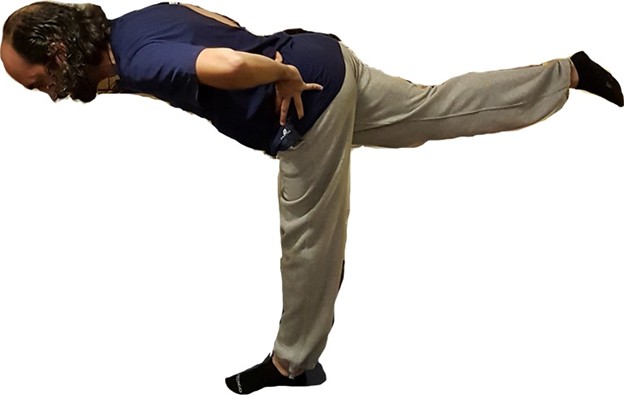Primary Objective of the Ásana
This balance posture improves the ability to balance, promotes good health and strength throughout the legs, especially the nerves.
Number of repetitions (standard): 4 rounds
Length of holding the position (ideal): 30 seconds
Breath: Continuous. No kumbhaka.

| Steps of practice | Further details & rationale |
| 1. – Stand naturally with your feet hip-width apart. You should feel well-grounded through the four corners of the feet. – Inhale, bend the elbows and bring the hands to the waist. Shift the weight over onto the left leg, slightly microbending the left knee. – Exhale, stepping the right foot back about 30 centimeters, with the toes still touching the floor to stabilize the position. | – To avoid hyperextension of the knee in this posture, the left knee should not be “locked”. Rather, slightly bend the knee and lift the kneecap to transfer the stress from the joint to the surrounding muscles. – The shoulders are relaxed and the chest/heart center is open. – With the hands on the waist, the elbows may be moved toward each other posteriorly to open the chest. |
| 2. – Lift the back foot off the floor a little to find your balance. -Then lean forwards slowly from the hips while simultaneously raising the right leg. The right leg and trunk are in one straight line, ideally parallel to the floor; or slightly slanted – Fix your gaze at a point on the floor to assist balance -Breathe naturally. -Hold the position for up to 30 seconds. | – Leading the movement with the back foot helps keep the leg in line with the torso/trunk while assuming the posture. – The back foot should be in neutral position -Keep the hips straight, squared towards the front in the beginning and to the floor in the completed pose. The center of the navel should be aligned with the standing foot -Keep the neck long and not tilted with the face facing squared to the floor |
| 3. – To release the pose, slowly return to an upright position. | – Leading the movement with the “back of the head” helps to keep the body in a straight line while coming out of the posture. |
| 4. -Take a few breaths in Tadasana, then repeat the process standing on the right foot to complete one round. -Practice 4 rounds. -After the last repetition, rest in Tadasana for a few breaths to integrate the effects of the ásana and let the body recover. | |
Preparatory Steps
- To lengthen calves, hamstrings and abductors: Sahaja Utkatásana/Simple chair.
- Standing hip, knee, and/or ankle rotations.
- Hip extension exercises: Bhújaungásana/Cobra, Utkata Vajrásana/Difficult thunder.
- To warm up the entire body: Padahastásana/Arm and leg pose. Karmásana/Action pose, Surya Namaskar/Sun salutation.
Considerations
Safety essentials and modifications
- Keep the gaze fixed at a steady point on the floor to facilitate balance.
- Keep the raised leg straight.
- The lifted leg can be diagonal.
- Place the back foot on the wall (facing away from the wall) to help square the hips and stabilize the pose.
- If you struggle with balance: Stand parallel to the wall and place one elbow into the wall to steady the balance.
- Foot on dorsiflexion depending on the feeling you want to achieve in the pose.
Common misalignments
- In the Warrior 3 Variation arms may wander away from ears.
- Dropping the head down out of alignment with the spine.
- Sometimes the balance is lost and the pose cannot be held for long. Re-focus and gently strengthen the determination.
- The back raised foot is over-engaged and not relaxed.
- Hip is not squared to the floor. It is turned.

Variations
- Place the back of the hands on the sacrum, or rest the interlaced fingers on the sacrum.
- Place the hands in Namaskar Mudra in front of the heart.
- Stretch the hands straight ahead as in Virabhadra III (Warrior III as illustrated).
- Standing Airplane pose with arms out to the sides.
Benefits
- Strengthens shoulders, arms, legs, knees, core, and back muscles.
- Increases focus and determination.
- Improves vigor and vitality.
- Tones abdominal organs.
- Highly recommended for athletes and runners.
- Improves posture, bearing and carriage – encourages balanced distribution of weight on the feet and keeps the stomach muscles activated (Uddayana Bandha).
- Enhances mental and physical agility.
- Cultivates patience, concentration and endurance.
Visualizations & Ideations
- I feel my base leg is rooted to the earth like a tree (or a mountain).
- I visualize harmony between the strong vertical line of the leg (rootedness) and the floating horizontal line of the body (freedom).
- The body-mind balance I have is transferred into a successful life.
- I embrace the dance of life.